A conversation with Leigh Werrell
by Elizabeth Johnson, edited by Matthew Crain
A conversation with Leigh Werrell
by Elizabeth Johnson, edited by Matthew Crain

Ashley's House, 24" x 20", Foamcore, Newsprint, Gesso, Oil Paint On Panel
Elizabeth Johnson: In the Gross McCleaf statement you mention "approaching the communal through the personal" and the "seemingly contradictory feelings of being lonely in a crowd and feeling a sense of community among individuals." Were the pandemic years especially meaningful for you since we were together in our loneliness? If so, how did the pandemic affect your work?
Leigh Werrell: The pandemic has really changed me as a person––as I believe it has many people––and I think it has certainly changed my work. Throughout the last few years, I have been grappling with personal ideas of how I want to live, what is important to me, and what my studio practice means to me. I have realized two things: without a community to show my work to, I find it very hard to create; and to feel fulfilled I need to be making art. Not having that strong group of fellow artists, familiar gallery-goers, and other friends available to me for about two years was difficult, and I took a break from painting. When I returned, I had a lot of pandemic images in my head. Pre-pandemic, a lot of my work came from places I would frequent with friends, restaurants, someone else’s house...But the work in this show comprises mainly empty spaces and individual people or separates the viewer from a space that they either can’t enter or can’t fully see into. The pre-pandemic work feels clearer and more open, and I suppose that reflects the era we are living in.

Loveseat, 8.5" x 13.5", Papier mâché, Gesso, Oil Paint On Wood Panel
EJ: Color seems to be central to your storytelling, and many works are unified by a single color. For instance, Loveseat is bathed in passionate reds and Mailbox glows with a particularly accurate post office blue. Are your stories and memories generally triggered or accessed by specific colors?
LW: I certainly love color! I usually start a painting with an overall color in mind, but I choose the color based on what I feel about the memory or story, not the other way around. Loveseat was made in 2018 after I had met my fiancé and I was falling in love. I was having a lot of romantic feelings, and I thought it would be fun to make this piece the most obnoxious Pepto-pink color.
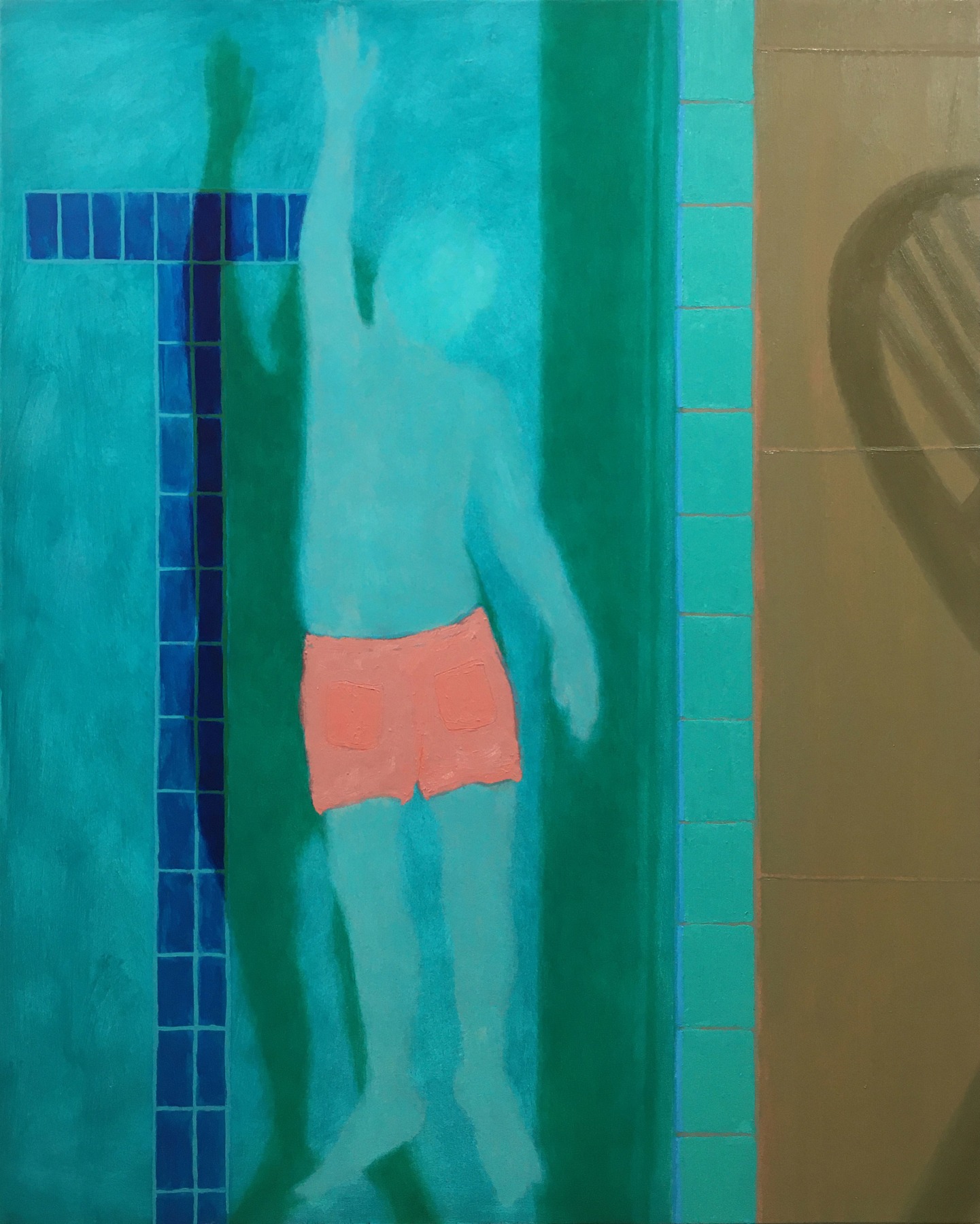
Swimmer 1, 24" x 19", Oil On Panel
LW: Other examples are the Swimmer pieces, which are based on memories from my childhood when I was obsessed with being in the pool. I really wanted that specific bright blue because it enveloped that time and is a nostalgic color for me. Other colors evoke a mood or even a temperature, like in Summer Windows that feels hot and humid.
I feel that all my work requires specific colors to convey a story. They give meaningful value to the work by providing a clearer narrative, though ambiguity is still very important to me. Creating a white or monochromatic sculptural piece can be great, but a neutral or static color also brings a loaded meaning to a piece. So, I choose whatever color makes the most sense for the work.
EJ: You excel at expressing color that glows at night. Events of strong color are personal since you noticed them, and you share them by painting them. Dépanneur seems to connect social longing, since you are on the outside of an inviting space, with the joy of navigating the city at night alone. For me, the painting recalls the jarring sound of a bodega buzzer or crossing a threshold between opposites. Do you associate a story with this painting?
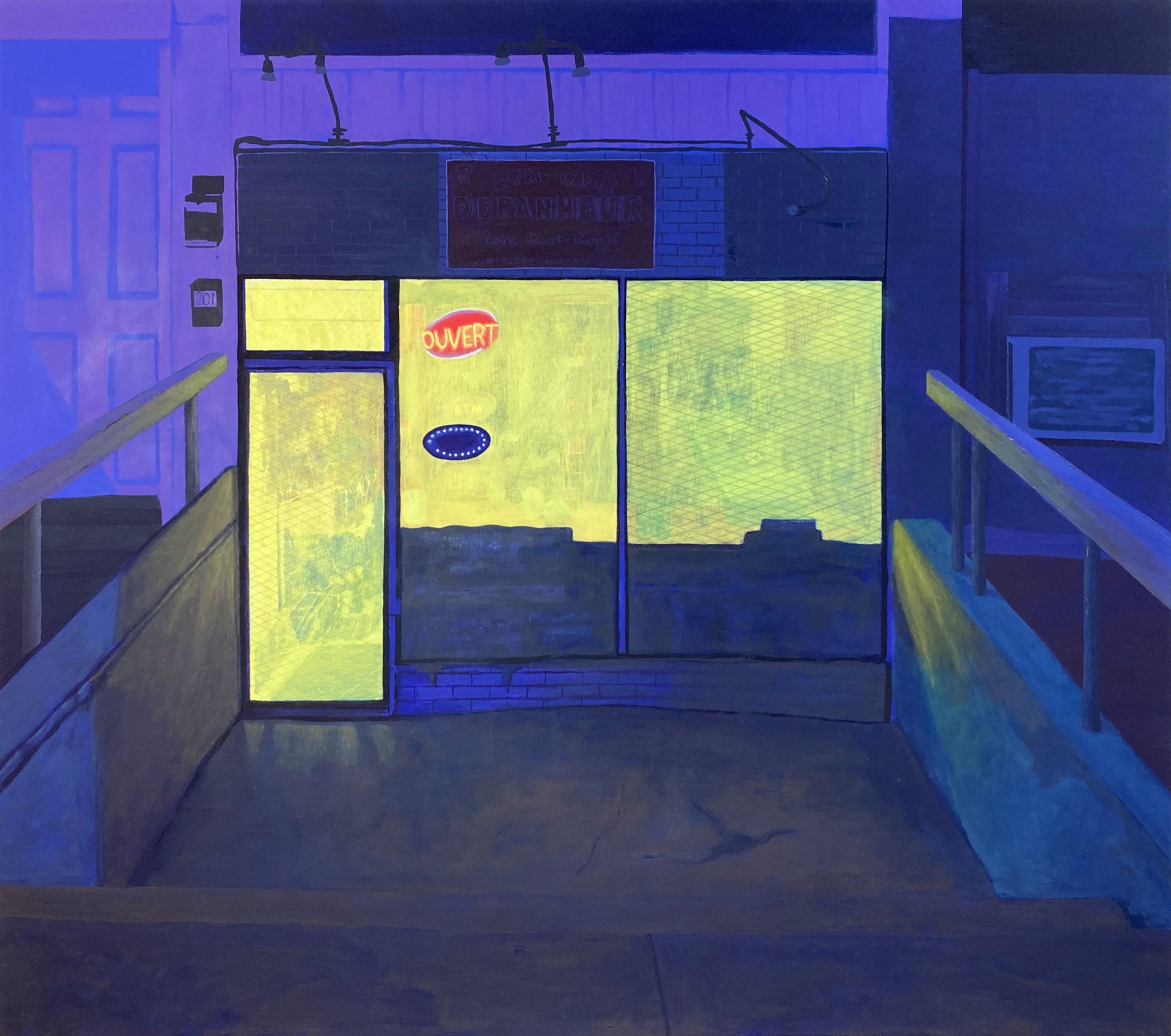
Dépanneur, 32" x 36", Oil On Panel
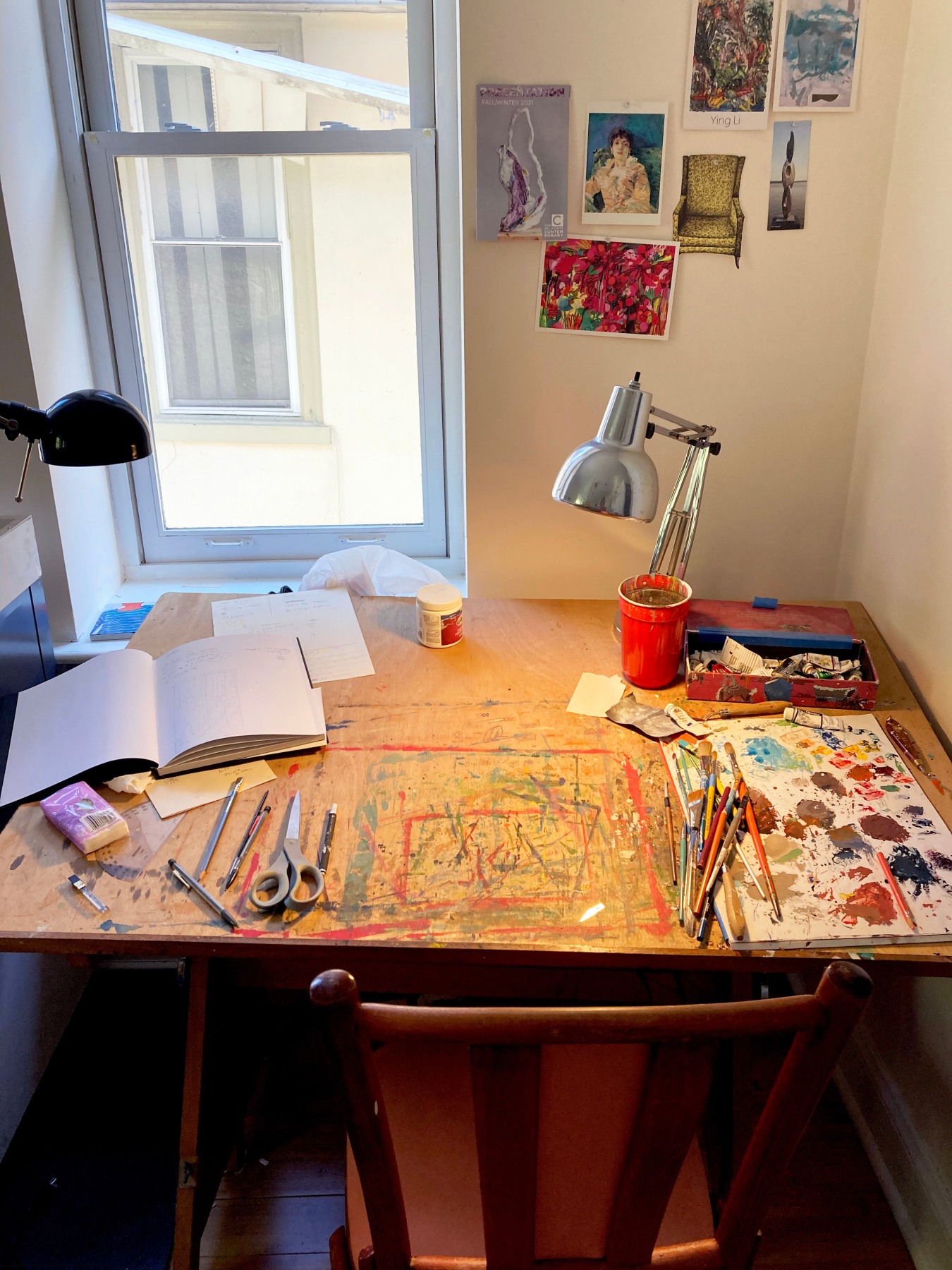
Leigh Werrell's Studio
LW: Dépanneur had been in my mind for a long time, since visiting Montreal in 2018. I went with some friends I had met at Vermont Studio Center; we drove up after the residency and walked around for a couple days. Montreal was a conundrum for me in that it felt familiar and foreign at the same time. Instead of being in a new city, it felt like I had walked from my home in Philly into a new neighborhood. I really love walking around, and that’s how I get most of my ideas for paintings. One of my favorite activities is finding something new in the familiar.
This corner store was interesting because its entrance was on a lower level, almost like it was buried under the other buildings. The light and level of transparency of the windows also attracted me. I was interested in how to present the objects inside without showing them, and the transition of focus in vision that happens when looking through a window. This painting remained attractive throughout the pandemic since I thought a lot about being on the outside and looking in through windows, TV, and computer screens, and the feeling of being isolated from friends and family.
EJ: Is papier-mâché a new material for you? How did you become involved in it? Does working in 3-D color enhance story or memory more than painting for you? Your Gross McCleaf statement says, "neon lights come forward, seeking attention, fulfilling their purpose. Items in my house have the same objective. I paint and sculpt those objects and scenes that, through meaning or aesthetic, bring me closer to them. . . ."
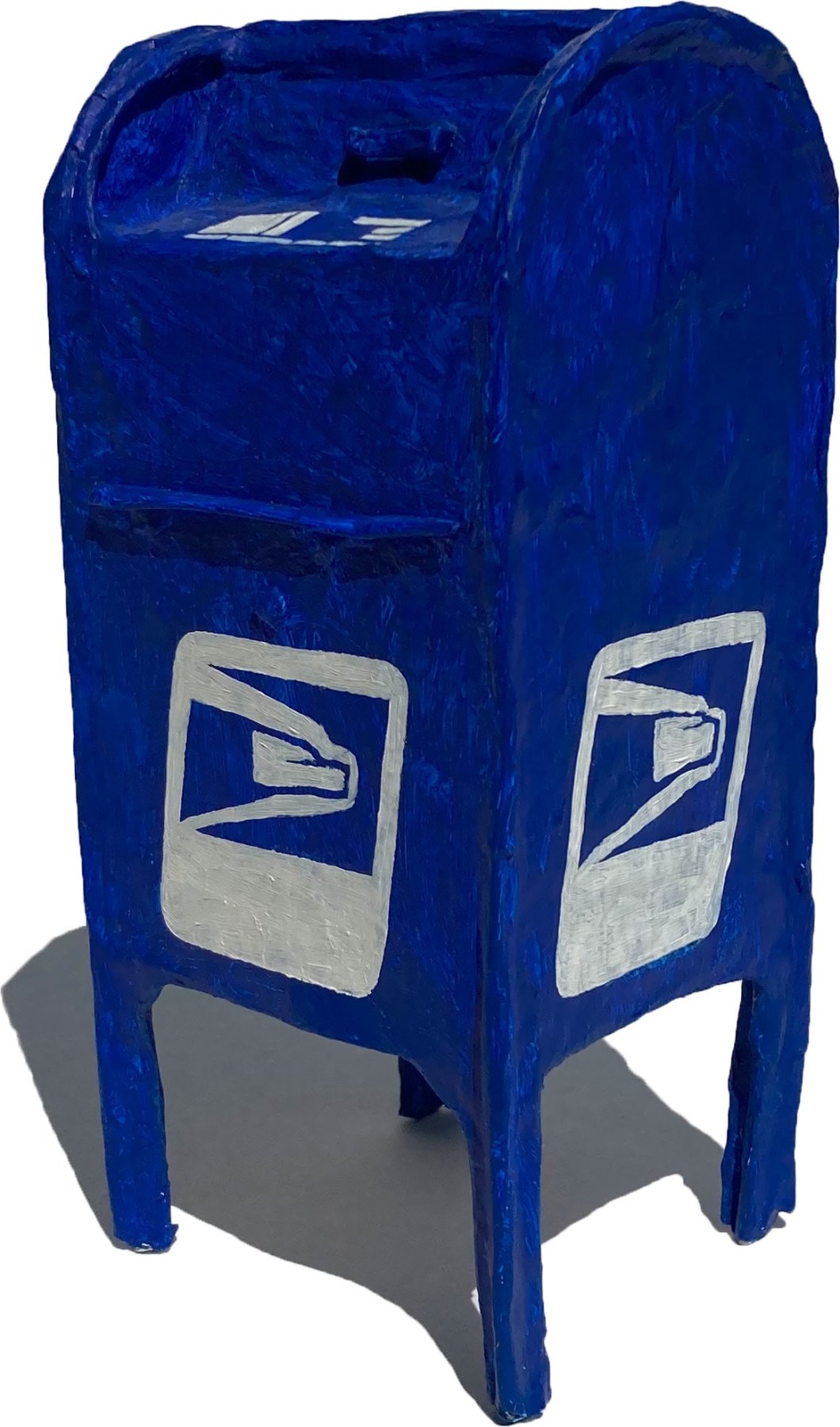
Mailbox, 8" x 3.5" x 3", Papier-mâché, Gesso, Oil Paint
LW: Papier-mâché is a new process for me. My interest in 3-D forms is longstanding, you could say I’ve been doing 3-D “sketches” in paper for quite a while now. These came out as what I call “dioramas”––attempts to create 3-D scenes resembling a painting. When I was at Vermont Studio Center in 2018, I visited the Bread and Puppet Theater and found these fantastic small pieces (I believe the artist was either Peter or Elka Schumann) that looked like marble relief sculptures of horses and people but were made of papier-mâché. They reminded me of James Castle’s cardboard shapes. Also, I had been looking at a lot of Joseph Cornell and really enjoyed how he could fit in so much emotion, framed in a shallow space. I made Loveseat at that residency.
Saying, “I paint and sculpt those objects and scenes that, through meaning or aesthetic, bring me closer to them” means that I focus on familiarity in artwork. I want to connect to the scenes and objects in my work, and I believe that if I am connecting with them, other people will too. People are in the world to be seen, and the best expression of being seen comes with learning that you have had the same experience as someone else. For instance, reading a book that you can relate to or observing how another person has been as delighted as you have been with a shape or color that you have seen in a different context. Inhabiting their perspective can shift your ideas about that object, scene, or story.
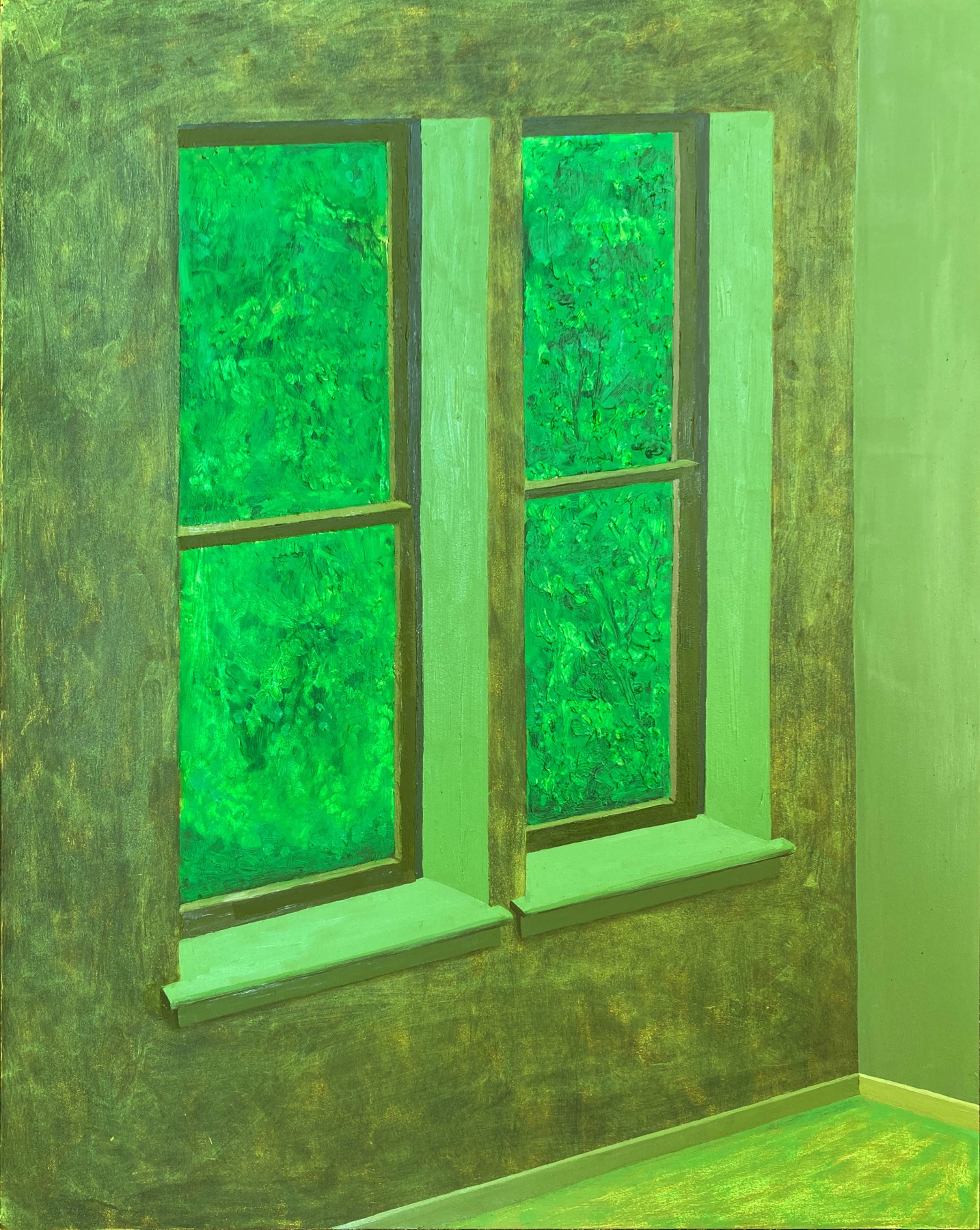
Summer Windows, 24" x 19", Oil On Panel
EJ: Summer Windows expresses aggressive green light entering windows, as if summer is overbearing or too much of a good thing. On the other hand, Twilight and Red Barn present retreating or subtle light effects. Are light effects seldom or never neutral to you?
LW: I don’t think of it so much as light effects as I do setting a mood, creating an interesting tonal composition, or looking at a specific color via light moving through something. Most painters are required to consider light, as it is an integral part of composition––one of the most basic lessons in two-dimensional art is how to use light and shadow. I saw the fantastic Jennifer Packer show at the Whitney, and while she uses tone to create wonderful compositions, her work doesn’t care that much about light as a concept within the scene, other than creating stunning luminescent colors. Even when my work isn’t looking directly at light coming into a space, I'm always considering how to manifest luminescence that I see within different objects or environments, such as in the pool paintings. The only time that it hasn’t been as important to me is when I create sculptural works, as they are lit by real light in the real world.
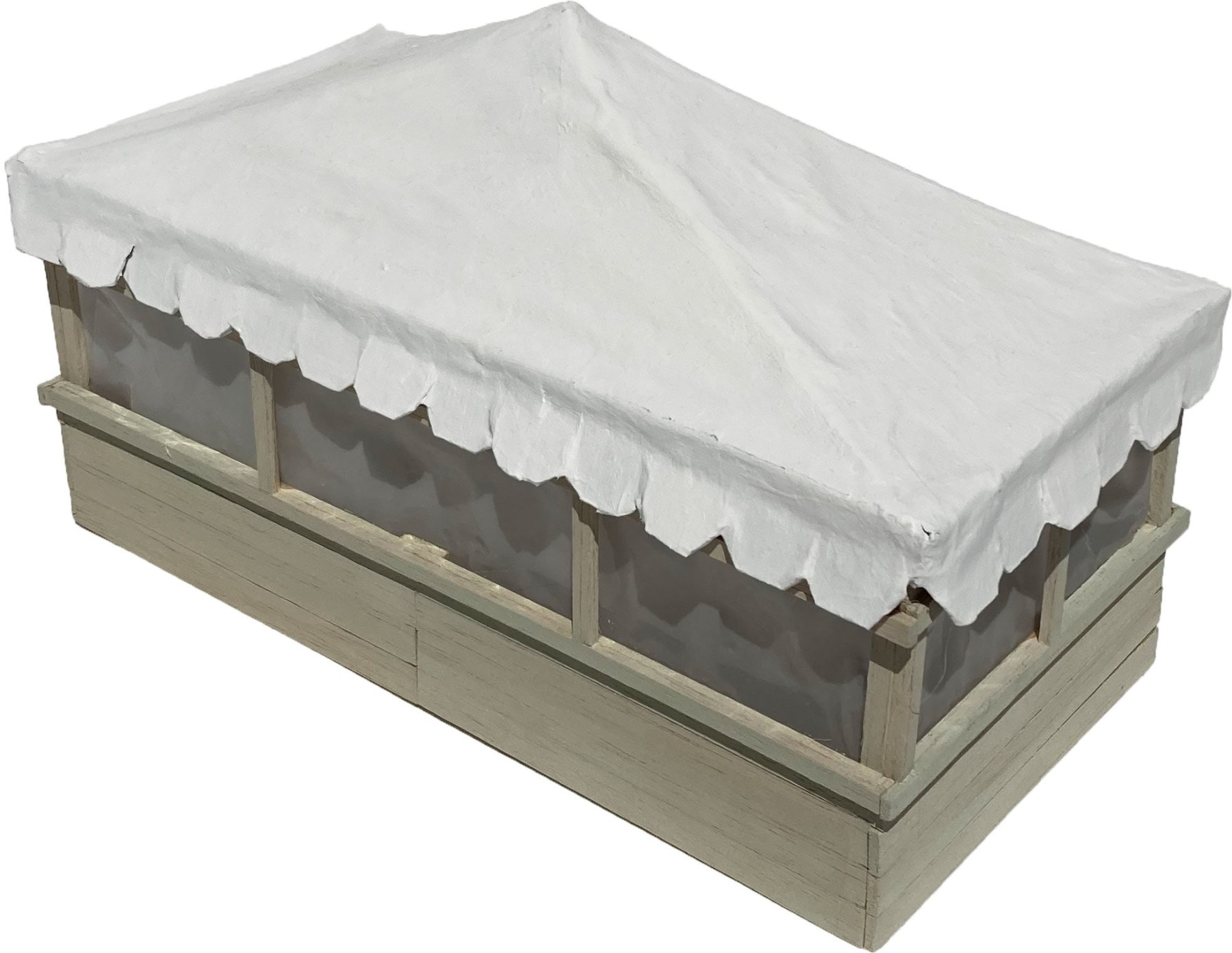
Tent, 6" x 12" x 7", Papier-mâché, Gesso, Wood, Plastic, String Lights
EJ: Tent is fun because it withholds information like No Parking: it teases the viewer's imagination and alludes to being shut out of wealth. Their mysteries feel more pointed than the voyeurism of South Philly Façade, since I associate white tents and private garage buildings with rich property owners. Do these pieces concern class and wealth in Philadelphia?
LW: Tent is about a feeling of ambiguity and being shut out. I made it in the middle of the pandemic, and it is based on both the now ubiquitous COVID dining tents at restaurants and medical tents. I liked the idea of the tent having no doors and opaque plastic over the windows, so nobody could see or come in. (Although it does have tiny string lights inside to remind you of the fun you are missing.) The piece expresses anxiety, being out of control and isolated and not knowing when the pandemic would end.
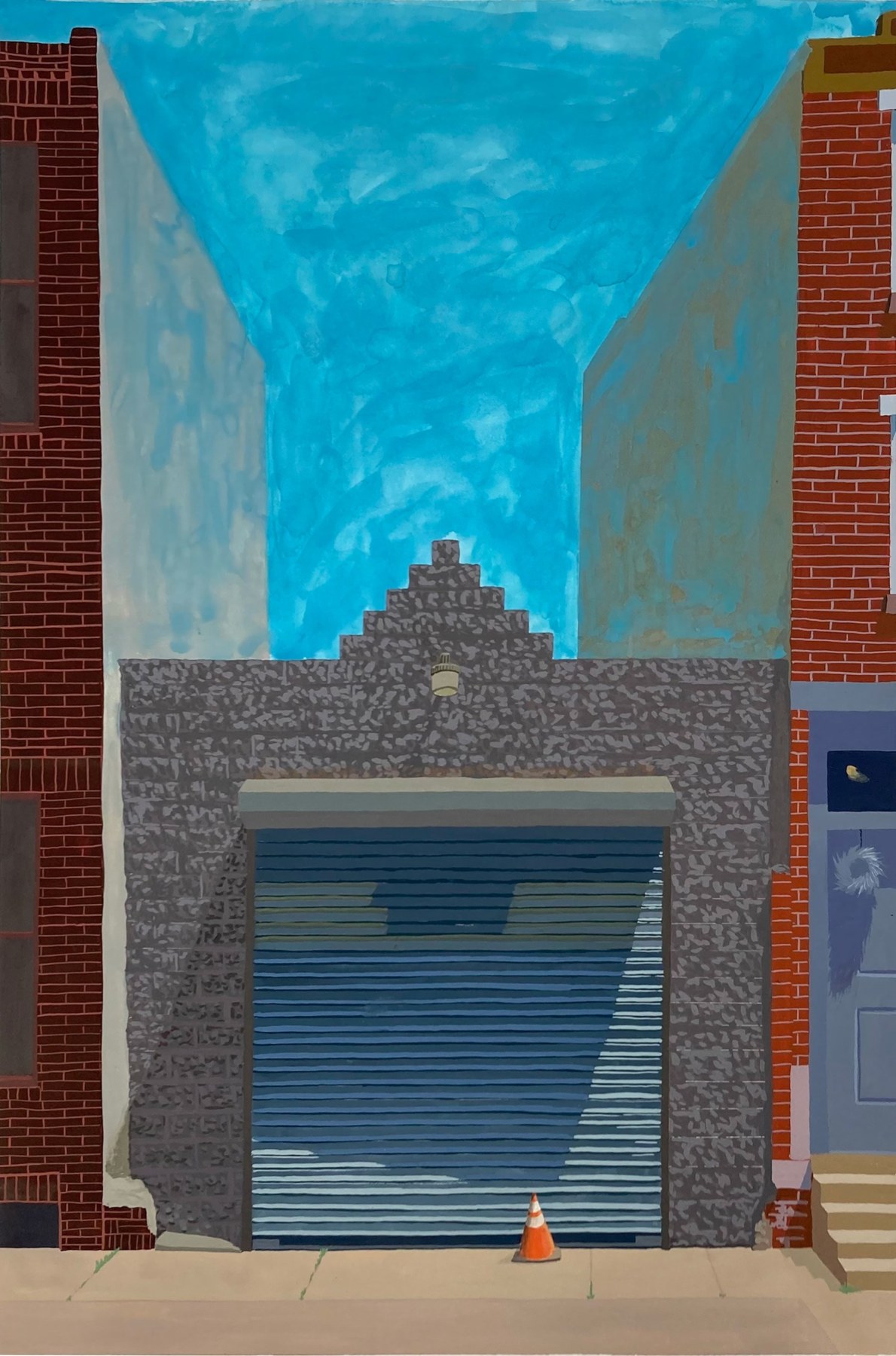
No Parking, 25" x 19", Gouache
LW: The COVID tent recalled lifestyles that my principles weren’t allowing me to live at that moment. I was angry at those who were unnecessarily prolonging the pandemic through irresponsible behavior, while also living behind a curtain of anonymity. To your question: I think this idea is translatable as a conceptualization of people who do not consider the implications of the gentrification that they help perpetuate.
On the one hand, with No Parking I came to the image aesthetically: I was interested in these two rowhomes in South Philly with an empty space in between and the feeling of negative space among tightly packed homes unseen behind that door. However, I don’t think one can look at any neighborhood in Philadelphia without being reminded of the impact that wealth, class, and racial prejudice have on who is able to live here.
EJ: When you put figures in your work, such as in Loveseat, is this a deviation from the norm? As you said maybe fueled by new love? You highlight the ambiguous space between you and me, and generously invite others to inhabit it in their imagination. Now that we are coming out of quarantine, do you want to return to figuration?
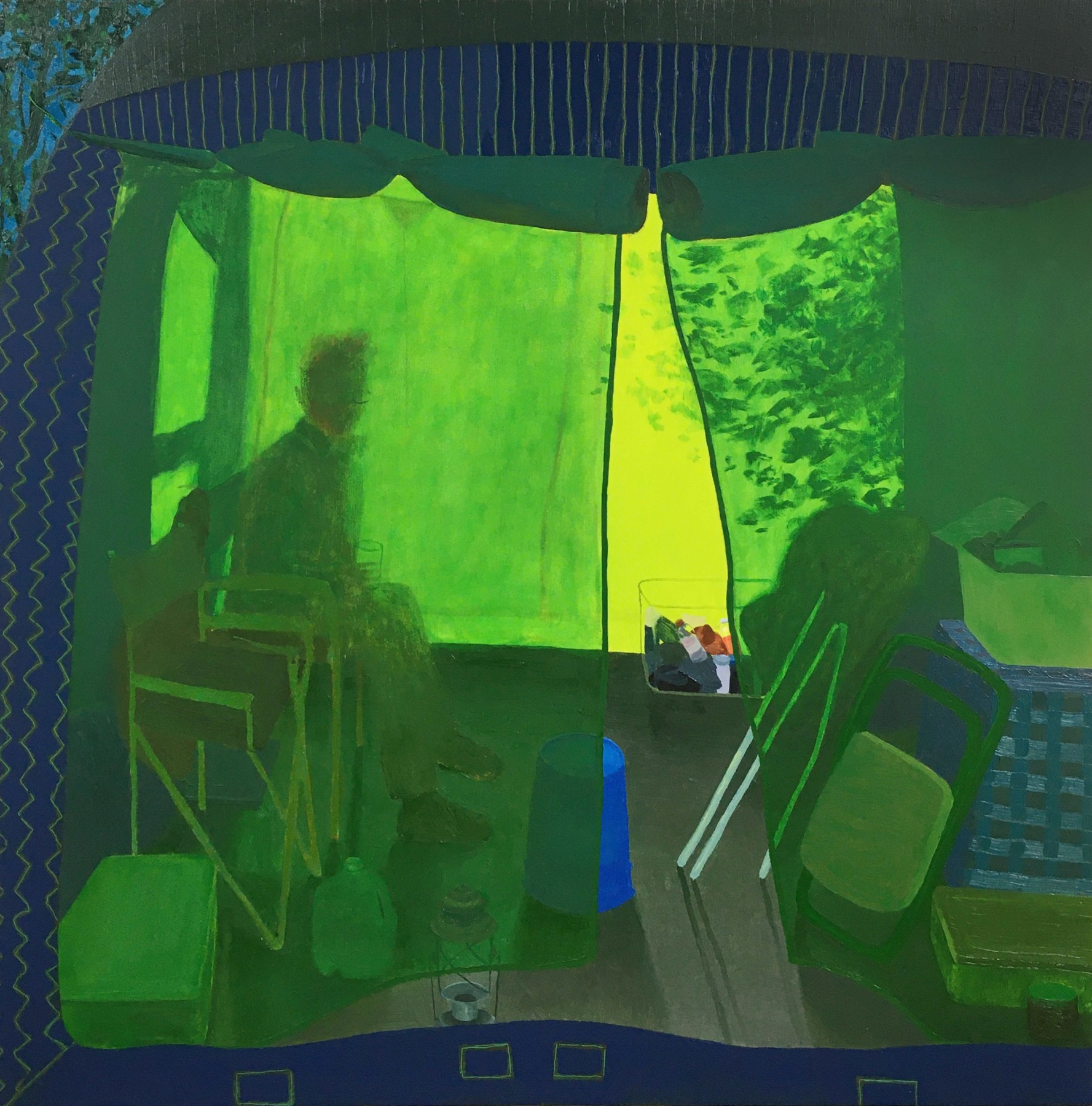
Camping With Henry, 28" x 28", Oil On Panel
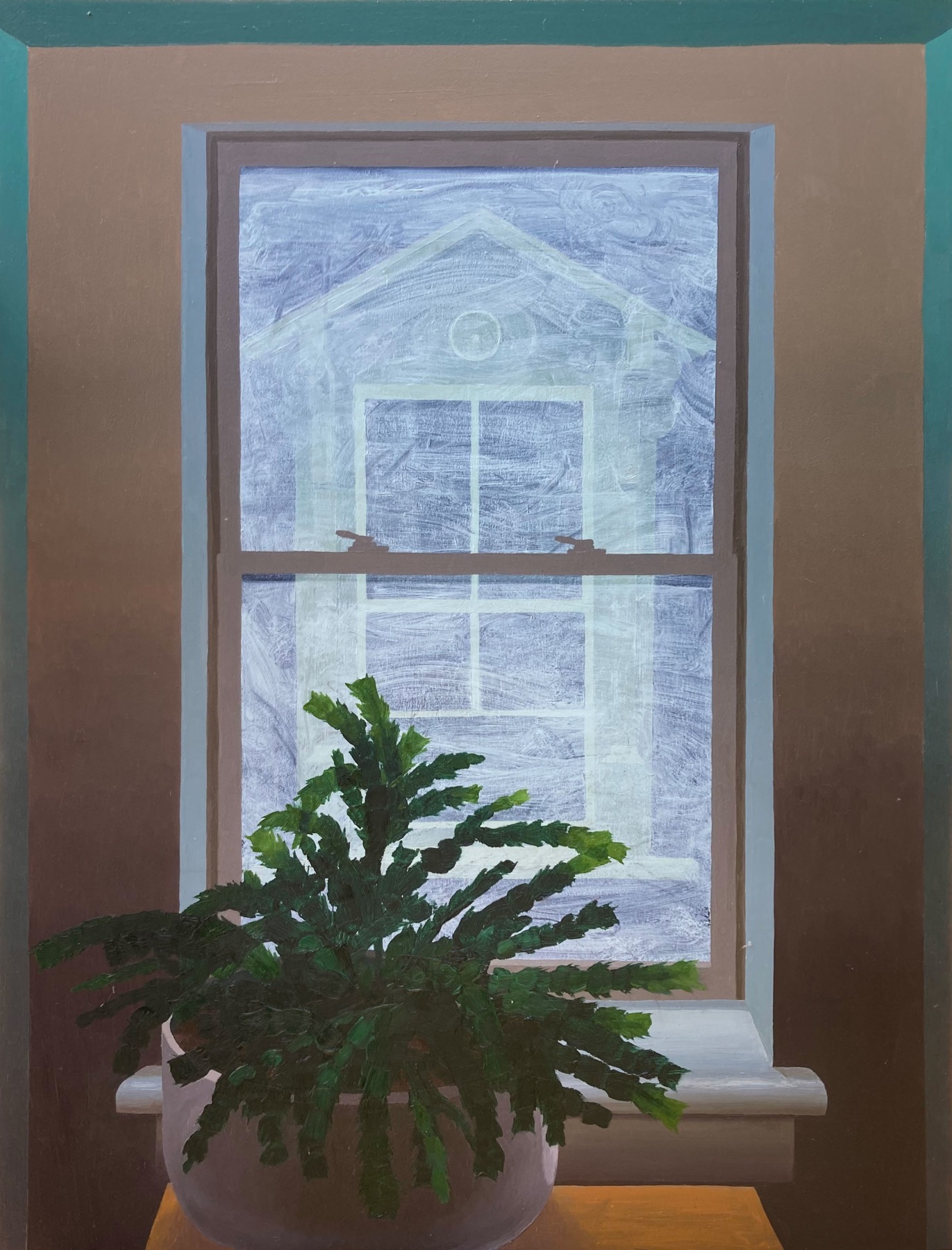
Window In Window, 19" x 14.5", Oil On Panel
LW: I made the work in this exhibition while deep in the pandemic mindset, which kept me from seeing as many people as I used to. My MFA work was focused on portraiture, I was just around more people back then, and as a twenty-three-year-old, I had more interest in socializing. I do have a couple of painting ideas brewing, but so far, they are mostly concerned with looking out windows. So, I guess the answer is no, I don’t feel drawn to using figuration more than I have in the past few years. But who knows? That could change. Are we coming out of the pandemic? It’s hard to tell. The world is different now and I don't know the rules.
––Elizabeth Johnson
(elizabethjohnsonart.com)
edited by Matthew Crain
(Instagram: @sarcastapics)
October 2022